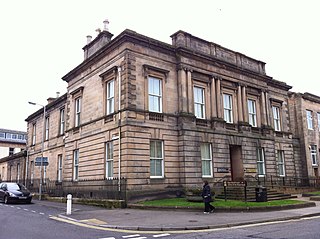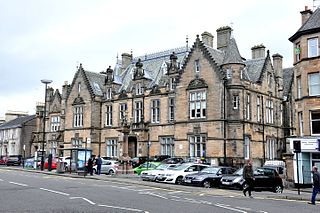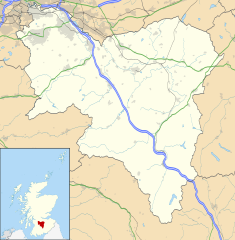
Inveraray Jail is a former prison and courthouse in Church Square, Inveraray, Argyll and Bute, Scotland. It was built in 1820 and is a Category A listed building. The prison closed in 1889 but the building remained in use as a courthouse until the mid-twentieth century, in which time it was also used for some meetings of Argyll County Council. Since 1989 it has been a museum.

The Corinthian Club is a private members club in Ingram Street, Glasgow, Scotland. It is accommodated in former bank building which, as Lanarkshire House, became the headquarters of Lanarkshire County Council. It is a Category A listed building.

County Buildings is a municipal complex in Wellington Square, Ayr, Scotland. The complex serves as the meeting place of South Ayrshire Council. The original structure, the former sheriff court at the eastern end of the complex, is Category A listed building, while the main office building at the western end of the complex, is a Category B listed building.

Perth Sheriff Court is an historic building on Tay Street in Perth, Perth and Kinross, Scotland. The structure, which is used as the main courthouse for the area, is a Category A listed building.

Kirkcudbright Town Hall is a municipal building in St Mary's Street, Kirkcudbright, Scotland. The building, which was the headquarters of Kirkcudbright Burgh Council, is a Category B listed building.

Forres Town Hall is a municipal structure in the High Street, Forres, Moray, Scotland. The structure, which was the meeting place of Forres Burgh Council, is a Category B listed building.

The Old Sheriff Court is a former municipal and judicial building in Wilson Street, Glasgow, Scotland. The building, which is home to the Scottish Youth Theatre, is a Category B listed building.

The Justiciary Buildings is a judicial complex in the Saltmarket in Glasgow, Scotland. The complex, which operates in conjunction with similar facilities in Edinburgh and Aberdeen, is dedicated for the use of the High Court of Justiciary, which is the supreme criminal court in Scotland. It is a Category A listed building.

Banff Sheriff Court is a judicial structure in Low Street, Banff, Aberdeenshire, Scotland. The structure, which was the headquarters of Banffshire County Council and was also used as a courthouse, is a Category B listed building.

Elgin Sheriff Court is a municipal structure in the High Street, Elgin, Moray, Scotland. The structure, which was the headquarters of Morayshire County Council and remains in use as a courthouse, is a Category B listed building.

Paisley Sheriff Court is a municipal structure in St James Street, Paisley, Renfrewshire, Scotland. The complex, which was the headquarters of Renfrewshire County Council and is currently used as a courthouse, is a Category A listed building.

Dumbarton Sheriff Court is a judicial structure in Church Street, Dumbarton, West Dunbartonshire, Scotland. The complex, which was the headquarters of Dunbartonshire County Council and is currently used as a courthouse, is a Category B listed building.

Wick Sheriff Court is a judicial structure in Bridge Street, Wick, Caithness, Scotland. The structure, which remains in use as a courthouse, is a Category B listed building.

Stonehaven Sheriff Court, formerly known as County Buildings, is a judicial structure in Dunnottar Avenue, Stonehaven, Aberdeenshire, Scotland. The structure, which was used as the headquarters of Kincardineshire County Council as well as a courthouse, is a Category B listed building.

The Justiciary Building is a judicial structure in the Lawnmarket in Edinburgh, Scotland. The structure, which operates in conjunction with similar facilities in Glasgow and Aberdeen, is dedicated for the use of the High Court of Justiciary, which is the supreme criminal court in Scotland. It is a Category B listed building.

Stranraer Sheriff Court is a judicial building in Lewis Street, Stranraer, Dumfries and Galloway, Scotland. The building, which continues to be used as a courthouse, is a Category B listed building.

Hamilton Sheriff Court is a judicial building in Almada Street, Hamilton, South Lanarkshire, Scotland. The building, which continues to serve as the local courthouse, is a Category A listed building.

Lanark Tolbooth is a municipal building in Hope Street, Lanark, South Lanarkshire, Scotland. The building, which now operates as an arts and heritage centre, is a Category B listed building.

Stirling Sheriff Court is a judicial building in Viewfield Place, Stirling, Scotland. The building, which remains in use as a courthouse, is a Category B listed building.

Forfar Sheriff Court is a judicial building in Market Street, Forfar, Angus, Scotland. The building, which remains in use as a courthouse, is a Category B listed building.





















